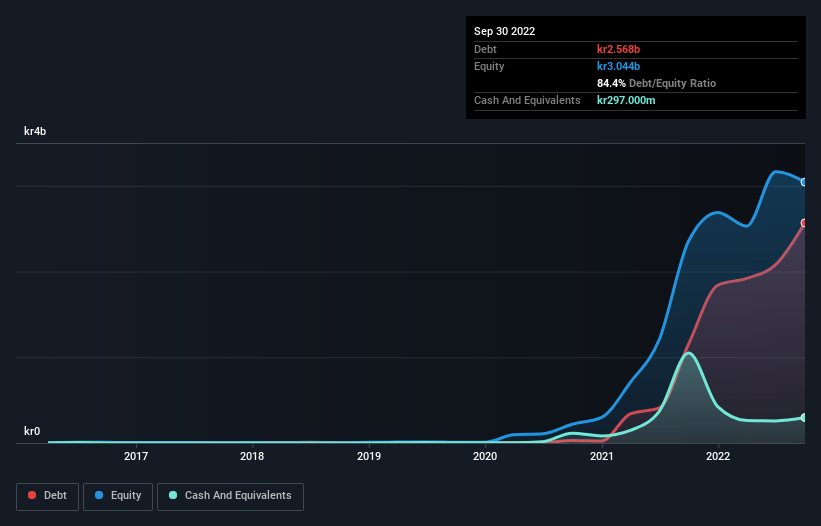- Sweden
- /
- Personal Products
- /
- OM:HUMBLE
Health Check: How Prudently Does Humble Group (STO:HUMBLE) Use Debt?
Some say volatility, rather than debt, is the best way to think about risk as an investor, but Warren Buffett famously said that 'Volatility is far from synonymous with risk.' When we think about how risky a company is, we always like to look at its use of debt, since debt overload can lead to ruin. We can see that Humble Group AB (publ) (STO:HUMBLE) does use debt in its business. But the more important question is: how much risk is that debt creating?
What Risk Does Debt Bring?
Debt is a tool to help businesses grow, but if a business is incapable of paying off its lenders, then it exists at their mercy. In the worst case scenario, a company can go bankrupt if it cannot pay its creditors. However, a more frequent (but still costly) occurrence is where a company must issue shares at bargain-basement prices, permanently diluting shareholders, just to shore up its balance sheet. Of course, plenty of companies use debt to fund growth, without any negative consequences. When we think about a company's use of debt, we first look at cash and debt together.
Check out our latest analysis for Humble Group
How Much Debt Does Humble Group Carry?
The image below, which you can click on for greater detail, shows that at September 2022 Humble Group had debt of kr2.57b, up from kr1.16b in one year. On the flip side, it has kr297.0m in cash leading to net debt of about kr2.27b.

A Look At Humble Group's Liabilities
The latest balance sheet data shows that Humble Group had liabilities of kr1.63b due within a year, and liabilities of kr3.17b falling due after that. Offsetting this, it had kr297.0m in cash and kr889.0m in receivables that were due within 12 months. So it has liabilities totalling kr3.61b more than its cash and near-term receivables, combined.
Given this deficit is actually higher than the company's market capitalization of kr2.99b, we think shareholders really should watch Humble Group's debt levels, like a parent watching their child ride a bike for the first time. Hypothetically, extremely heavy dilution would be required if the company were forced to pay down its liabilities by raising capital at the current share price. There's no doubt that we learn most about debt from the balance sheet. But ultimately the future profitability of the business will decide if Humble Group can strengthen its balance sheet over time. So if you're focused on the future you can check out this free report showing analyst profit forecasts.
In the last year Humble Group wasn't profitable at an EBIT level, but managed to grow its revenue by 508%, to kr4.2b. That's virtually the hole-in-one of revenue growth!
Caveat Emptor
While we can certainly appreciate Humble Group's revenue growth, its earnings before interest and tax (EBIT) loss is not ideal. Indeed, it lost a very considerable kr781m at the EBIT level. Considering that alongside the liabilities mentioned above make us nervous about the company. We'd want to see some strong near-term improvements before getting too interested in the stock. Not least because it had negative free cash flow of kr36m over the last twelve months. So suffice it to say we consider the stock to be risky. There's no doubt that we learn most about debt from the balance sheet. However, not all investment risk resides within the balance sheet - far from it. We've identified 3 warning signs with Humble Group , and understanding them should be part of your investment process.
At the end of the day, it's often better to focus on companies that are free from net debt. You can access our special list of such companies (all with a track record of profit growth). It's free.
Valuation is complex, but we're here to simplify it.
Discover if Humble Group might be undervalued or overvalued with our detailed analysis, featuring fair value estimates, potential risks, dividends, insider trades, and its financial condition.
Access Free AnalysisHave feedback on this article? Concerned about the content? Get in touch with us directly. Alternatively, email editorial-team (at) simplywallst.com.
This article by Simply Wall St is general in nature. We provide commentary based on historical data and analyst forecasts only using an unbiased methodology and our articles are not intended to be financial advice. It does not constitute a recommendation to buy or sell any stock, and does not take account of your objectives, or your financial situation. We aim to bring you long-term focused analysis driven by fundamental data. Note that our analysis may not factor in the latest price-sensitive company announcements or qualitative material. Simply Wall St has no position in any stocks mentioned.
About OM:HUMBLE
Humble Group
Develops, refines, and distributes fast-moving consumer products in Sweden and internationally.
Reasonable growth potential with mediocre balance sheet.
Similar Companies
Market Insights
Community Narratives



